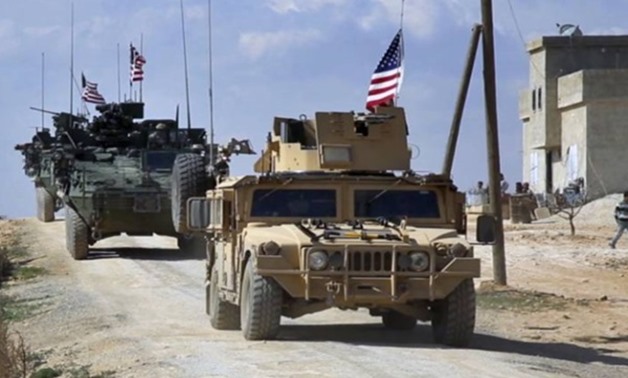
The Curse of the Islamic State’s Collapse - File photo
After six long years, no end to the conflict appears in sight. Under the guise of fighting terrorism, multiple proxy wars are rising from their covert origins and beginning to dominate the conflict. Eerily similar to during the Cold War, confrontations between the U.S. and Russia are increasingly direct and present a real challenge to global peace.
Raqqa and eastern Syria have become the epicenter of the tension between the U.S. and Russia, who have committed a vast deal of military and diplomatic capital to the conflict.
In the most significant clash so far, a U.S. warplane shot down a Syrian army jet in June because of their concern over its proximity to the U.S.-backed Syrian Defense Forces.
The coalition has stated it does “not seek to fight the Syrian regime, Russian or pro-regime forces;” however, it reacted as such “in collective self-defense of coalition-partnered forces.”
Unsurprisingly, the Russian response was hostile. Moscow stated that any plane flying west of the Euphrates River would be treated as a target, and has subsequently claimed to cut the communications hotline that was designed to prevent collisions in the air. The accepted channels of diplomacy are becoming progressively blurred.
Russia’s experience in Syria has been clear and consistent since its intervention began in 2015.The Soviet-era relationship, formally established in 1980, commits Russia to maintaining a certain level of loyalty to Assad; however, this is trumped by strategic and political motivations. Russia’s warm water at Tartus, Syria, provides year round access to the Mediterranean and is essential for Putin’s $132 billion plan to modernize the navy by 2020.
Understandably, Moscow
refuses to separate the Syrian experience to that in Libya in 2011. NATO’s unauthorized regime change in Libya has added fuel to the fire of distrust between Russia and the West; a fire that won’t be extinguished any time soon. Russian Foreign Minister Sergei Lavrov has insisted that Russia will “not allow the Libyan experience to be reproduced in Syria.”
Central to the government’s military advances, such as the symbolic victory in Aleppo, was Russian air support. Beyond this, however, Moscow’s political support for Assad in the U.N. Security Council has been indispensable. Russia has been the main vetoing force behind eight of the nine vetoed Security Council resolutions regarding Syria. Avoiding a repetition of what occurred in Libya, maintaining territorial, political and judicial sovereignty remain the principal justifications.
Although Moscow appears to unreservedly support Assad, the absence of a unified, credible opposition to Assad has forced Russia’s hand, as Assad remains the only person able to hold Syria together.
The U.S. position, in contrast, has been blurred and unsettled. The Obama administration undertook a campaign of support for a variety of “vetted” opposition groups, and American money and military supplies began to enter Syria via Jordan and Turkey, with U.S. troops flown in to provide training.
Obama’s success was mired by his demand that Assad’s departure was central to any settlement.
On the one hand, the eradication of the Islamic State (IS) was thought to be a major component in ending the conflict and thus Assad’s removal; however, crucially, it provided an acceptable basis for the U.S. military intervention that began in 2014.
The arrival of President Trump offered the promise of a sharp change in foreign policy. While the hope of improving relations with the Kremlin increased the possibility of a coordinated resolution, Trump had pledged to limit U.S. intervention abroad and instead focus on the situation at home.
Neither of these expectations have materialized.
With the city of Raqqa and eastern Syria remaining its last strongholds, the complete breakdown of IS’s territory in Syria is now a matter of when, and not if. However, this raises more questions than those answered. The U.S.-led military campaign should come to an end with the collapse of IS, yet the U.S. and her allies will undoubtedly retain their military presence.
In eastern Syria, the race is on to see who will control the area vacated by IS. Control of eastern Syria would likely assume control of Raqqa and provide a symbolic victory in ridding IS of its de facto capital. As the removal of IS opens new, unclaimed territory, the incentives for military supremacy are increased.
For Iran, securing a land corridor through Iraq and Syria to Lebanon and its allied Hezbollah is vital. Newfound access to the Mediterranean would also provide Iran strategic access to Europe.
Although the U.S. military declines to formally state how many U.S. troops are present in Syria, this number is sharply rising to support the battle for Raqqa, with Colonel Dorrian stating that “approximately an additional 400 enabling forces [will be] deployed for a temporary period.”
The situation in Syria is far from reassuring. Moscow’s consistency makes them easily read, whereas Trump’s flippant personality and inexperience creates deep uncertainty. As the war in Syria becomes a land-grab, each battle becomes more significant, with major powers wanting to capitalize on the billions of dollars they have spent on the campaign.
As IS’s downward spiral continues and the formal U.S.-led mission in Syria comes to an end, the U.S. and Russia must favor cooperation over competition to avoid an accidental war and establish peace. It must be remembered that the future of Syria must be dictated by the people of Syria, which cannot be overshadowed by great-power politics and the desire to bolster regional influence.

Comments
Leave a Comment